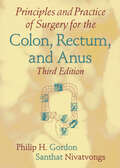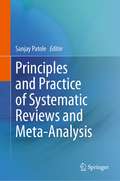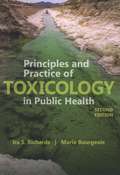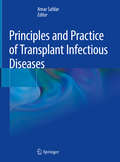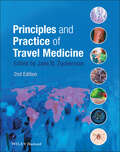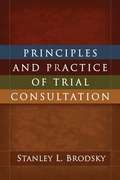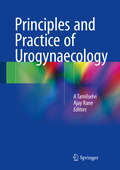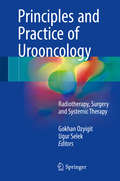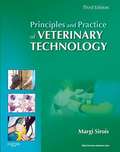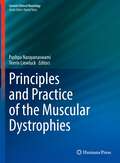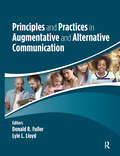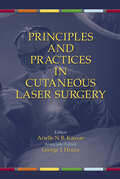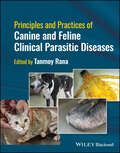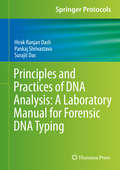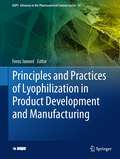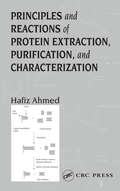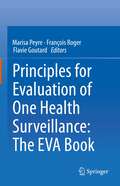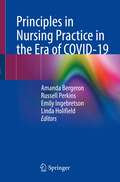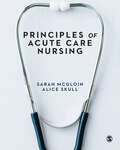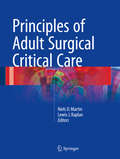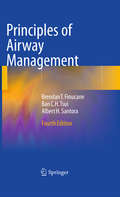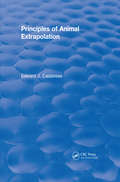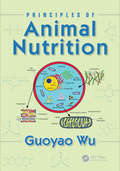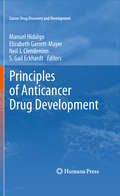- Table View
- List View
Principles and Practice of Surgery for the Colon, Rectum, and Anus
by Philip H. Gordon Santhat NivatvongsSupplying lavish color illustrations that fully detail key anatomical structures and pathology, this Third Edition encompasses the complete range of diseases encountered by colorectal surgeons in day-to-day clinical practice and spans topics related to anorectal disorders, colorectal conditions, problem-oriented approaches to colorectal disease, an
Principles and Practice of Systematic Reviews and Meta-Analysis
by Sanjay PatoleEvidence based medicine is at the core of modern medicine. It involves the integration of individual clinical expertise with the best available clinical evidence from systematic research and patient's values and expectations. Systematic reviews offer a summary of the best available evidence. They are the most reliable and comprehensive statement about what works. Written by clinical academics from Australia, UK, USA, and Switzerland, this contributed volume introduces the readers to the principles and practice of systematic reviews and meta-analysis. It covers the various steps involved in systematic reviews including development of a focused question and the strategy for conducting a comprehensive literature search, identifying studies addressing the underlying question, assessment of heterogeneity and the risk of bias in the included studies, data extraction, and the approach to meta-analysis. Crucial issues such as selecting the model for meta-analysis, generating and interpreting forest plots, assessing the risk of publication bias, cautions in the interpretation of subgroup and sensitivity analyses, rating certainty of the evidence using GRADE guideline, and standardized reporting of meta-analysis (PRISMA) are covered in detail. Every attempt is made to keep the narrative simple and clear. Mathematical formulae are avoided as much as possible. While the focus of this book is on systematic reviews and meta-analyses of randomised controlled trials (RCTs), the gold standard of clinical research, the essentials of systematic reviews of non-RCTs, diagnostic test accuracy studies, animal studies, individual participant data meta-analysis, and network meta-analysis are also covered. Readers from all faculties of medicine will enjoy this comprehensive and reader friendly book to understand the principles and practice of systematic reviews and meta-analysis for guiding their clinical practice and research.
Principles and Practice of Toxicology in Public Health
by Ira S. Richards Marie M. BourgeoisAll public health professionals should have some level of knowledge of the basic principles of Toxicology. Whether dealing with issues as diverse as a workers' compensation claim for a job-related exposure and injury or the removal of toxic wastes from an urban community, public health professionals must be able to communicate with each other, the public, and our political leaders concerning how chemicals can, and the conditions under which they may, realistically produce harm. Principles and Practice of Toxicology in Public Health provides students with an understanding of the nature and scope of the discipline, so that they may be prepared to participate in a meaningful way in the often highly visible problem-solving and decision-making processes required of public health professionals. In four sections, it offers an introduction to the field, as well as the basics of toxicology principles, systemic toxicity, and toxicology practice. The text is immediately readable for the student with little technical background. The Second Edition is a thorough update that has been expaneded with a new chapter on endocrine toxicology.
Principles and Practice of Transplant Infectious Diseases
by Amar SafdarThis comprehensive volume provides a platform from which both major and minor infectious diseases related issues are addressed in-depth among this highly susceptible population. The book begins with an overview of infections in various modalities. This is followed by chapters on clinical disorders, etiologic agents, therapeutics, and infection prevention. Chapters include easy-to-follow figures and tables, radiologic images, and pictorial demonstrations of various disease states to familiarize and reacquaint the transplant clinicians and surgeons in practice and training, and those belonging to subspecialties providing supportive care for these patients. Discussions to enumerate the noninfectious causes that mimic infectious diseases; clinical relevance and effective utility of existing and emerging diagnostic tools are presented throughout the book. Authored by leaders in their fields, this book is the go-to reference for management of patients undergoing hematopoietic and solid organ transplantation.
Principles and Practice of Travel Medicine
by Jane N. ZuckermanThis second edition of Principles and Practice of Travel Medicine has been extensively updated to provide a comprehensive description of travel medicine and is an invaluable reference resource to support the clinical practice of travel medicine.This new edition covers the many recent advances in the field, including the development of new and combined vaccines; malaria prophylaxis; emerging new infections; new hazards resulting from travel to long haul destinations; health tourism; and population movements. The chapter on vaccine-preventable diseases includes new developments in licensed vaccines, as well as continent-based recommendations for their administration.There are chapters on the travel health management of high risk travellers, including the diabetic traveller, the immuno-compromised, those with cardiovascular, renal, neurological, gastrointestinal, malignant and other disorders, psychological and psychiatric illnesses, pregnant women, children and the elderly.With increasing numbers of ever more adventurous travellers, there is discussion of travel medicine within extreme environments, whilst the chapter on space tourism may well be considered the future in travel medicine.Principles and Practice of Travel Medicine is an invaluable resource for health care professionals providing advice and clinical care to the traveller.
Principles and Practice of Trial Consultation
by Stanley Brodsky Joel DvoskinA pragmatic guide to a growing area of professional practice, this book describes the multiple roles of the trial consultant and provides tools for carrying them out competently and ethically. Leading authority Stanley Brodsky uses examples from actual trials and depositions to illustrate how knowledge and skills from psychology and related fields are applied in the legal context. He shows how to use scientific methods and findings to assist with jury selection, help attorneys focus their arguments, prepare witnesses for the rigors of cross-examination, and conduct change of venue evaluations. The examples are drawn from a wide range of civil and criminal cases. In addition to behavioral scientists, legal professionals also will find important insights and strategies in this book.
Principles and Practice of Urogynaecology
by A Tamilselvi Ajay RaneDespite the wide prevalence of urogynaecological problems, in clinical practice, there is a paucity of specialists that are skilled in the management of these conditions. The recognition of the need for a specialist to deal with these specific problems has led to the recent evolution of urogynaecology as a subspecialty. This book, Principles and Practice of Urogynaecology aims to equip the practicing professionals - Gynaecologists, Urogynaecologists and Urologists, with up-to-date information on the principles that guide the evaluation and management of pelvic organ prolapse and other common urogynaecological problems. With an emphasis on evidence based medicine, the book aims to deliver guidance on management of common urogynaecological problems and provides information on the latest cutting-edge surgical techniques. Written by global experts in the field of urogynaecology, the book focuses initially on pelvic floor anatomy and function, moving seamlessly to the evaluation and management of clinically relevant pelvic floor problems. A detailed discussion on management of mesh related complications is a highlight.
Principles and Practice of Urooncology
by Gokhan Ozyigit Ugur SelekThis evidence-based, state of the art guide to the management of urological malignancies, including bladder cancer, prostate cancer, and testicular cancer, is designed to serve as an easy-to-consult reference that will assist in daily decision making and the delivery of optimal care for individual patients within a multidisciplinary setting. Readers will find up-to-date information on patient selection and the full range of treatment modalities, including modern radiotherapy techniques, systemic chemotherapy, surgical procedures (including robotic surgery and other minimally invasive approaches), hormonal therapies, immunotherapy, and focal therapies. With regard to radiotherapy, the coverage encompasses everything from delineation of tumor volumes and organs at risk based on CT simulation through to delivery of stereotactic body radiotherapy, intensity-modulated radiation therapy, tomotherapy, volumetric modulated arc therapy, and proton therapy. The authors are leading authorities with international reputations who have been selected for their expertise in the topic that they address. The book will be of value for all practicing urooncologists as well as other oncology fellows and residents interested in urooncology.
Principles and Practice of Veterinary Technology (3rd Edition)
by Margi SiroisPrinciples and Practice of Veterinary Technology provides comprehensive coverage of the competencies every vet tech needs to know and offers excellent preparation for clinical practice and for veterinary technician credentialing examinations. This third edition has been designed primarily for the veterinary technician student with a particular focus on providing a ready reference on the diverse information that will be needed once the student graduates and begins working in the field.
Principles and Practice of the Muscular Dystrophies (Current Clinical Neurology)
by Pushpa Narayanaswami Teerin LiewluckThe field of muscular dystrophies has expanded significantly with the discovery of the genetic defects and protein products underlying these disorders. New treatments such as antisense oligonucleotides and siRNAs and gene therapies are now in clinical application and in trials. As clinical trials increase, outcome measurement becomes very important, and more validated tools are being developed. This book provides a comprehensive review of these disorders. Clinical features, diagnostic testing including genetic testing of these disorders, the basis and utility of genetic testing, and the basis of genetic therapies are all covered in detail. This book will provide neuromuscular neurologists, general neurologists, and neuromuscular fellows with a much needed update in the field.
Principles and Practices in Augmentative and Alternative Communication
by Donald Fuller Lyle LloydA definitive textbook for students in speech-language pathology, audiology, and communication sciences and disorders, Principles and Practices in Augmentative and Alternative Communication offers students an introduction to augmentative and alternative communication (AAC) and prepares them for working with clients with complex communication needs.Editors Drs. Donald R. Fuller and Lyle L. Lloyd and their contributors provide a foundation for the development of assessment and intervention procedures and practices within the framework of the communication model and its major components: the means to represent, the means to select, and the means to transmit.Principles and Practices in Augmentative and Alternative Communication consists of five major units: An introduction to AAC, from its history to current practice An overview of AAC symbols and a comprehensive discussion of aided and unaided symbols A review of AAC technology The components of AAC assessment: principles, vocabulary, symbol selection, and the prescription of AAC technology AAC intervention: everything from the components of the intervention process to examples from specific cases and settings Included with the text are online supplemental materials for faculty use in the classroom.Students and professionals looking for a foundational textbook in the field of AAC will find Principles and Practices in Augmentative and Alternative Communication to be effective, contemporary, and practical.
Principles and Practices in Cutaneous Laser Surgery
by Arielle N. B. Kauvar George J. HruzaWill full-color photographs throughout, this reference demonstrates and assesses various technologies and methods to effectively perform laser treatments for a variety of cutaneous disorders-emphasizing the selection of the appropriate laser for each clinical situation, practical treatment guidelines, and the avoidance of complications in the pract
Principles and Practices of Canine and Feline Clinical Parasitic Diseases
by Tanmoy RanaPrinciples and Practices of Canine and Feline Clinical Parasitic Diseases A comprehensive reference guide for specialists highlighting the parasitic diseases of dogs and cats with appropriate therapeutic strategy Parasitic diseases are a scourge for dogs and cats, and the impact of the numerous maladies associated with these diseases cannot be underestimated. For the clinician or researcher attempting to alleviate these symptoms, Principles and Practices of Canine and Feline Clinical Parasitic Diseases is a helpful, introductory practical guidebook that helps identify the parasites infecting these animals and suggests useful treatment strategies based on an appropriate diagnosis. Principles and Practices of Canine and Feline Clinical Parasitic Diseases comprehensively details its topic from symbiosis and parasitism, to therapeutics measures and control strategies, to the deleterious effect of parasites in various organs in dogs and cats. The book offers extensive information on management approaches, the most significant clinical findings, diagnostic approaches, disease prevention, and drug evaluation. As a reference, the guide provides systems for the identification of the pathogens and recognizes the severity and exhibition of disease manifestation. Principles and Practices of Canine and Feline Clinical Parasitic Diseases readers will also find: Preventative measures that can be utilized to prophylactically assure the continued health of the patient Chapters written by contributors with specialized knowledge in each particular subject presented The most up-to-date advanced research in the field of parasitic diseases Each chapter covers treatment schedules, details about the disease, and a management approach, using figures and line figures to aid in identification and treatment Principles and Practices of Canine and Feline Clinical Parasitic Diseases is ideal for undergraduates, postgraduates, researchers, academics, and industrialists interested in the various parasitic diseases and treatments. It is also extremely useful as a ready reference for scientists seeking to develop new anti-parasitic drugs.
Principles and Practices of DNA Analysis: A Laboratory Manual for Forensic DNA Typing (Springer Protocols Handbooks)
by Surajit Das Hirak Ranjan Dash Pankaj ShrivastavaThe book presents hands-on protocols for conventional and advanced forensic DNA fingerprinting experiments. It includes manual, semi-automatic, and advanced automatic techniques for DNA extraction from different biological samples.It also discusses various qualitative and quantitative approaches for the assessment of extracted forensic DNA. It contains protocols for the amplification of short tandem repeat markers (STRs) for the amplification-based target enrichment of the forensic samples.Further, it examines genotyping of the STR loci through capillary electrophoresis and includes real-world case studies where forensic DNA analysis has been used in the criminal and civil disputes. The book concludes by presenting technological developments in the field of DNA forensic analysis. Suitable for beginners, it is a key reference resource on a wide variety of DNA profiling techniques and applications.
Principles and Practices of Lyophilization in Product Development and Manufacturing (AAPS Advances in the Pharmaceutical Sciences Series #59)
by Feroz JameelThe biotechnology/biopharmaceutical sector has tremendously grown which led to the invention of engineered antibodies such as Antibody Drug Conjugates (ADCs), Bispecific T cell engager ( BITES), Dual Variable Domain ( DVD), Chimeric Antigen Receptor - Modified Tcells (CART) that are currently being used as therapeutic agents for immunology and oncology disease conditions. In addition to other pharmaceuticals and biopharmaceuticals, all these novel formats are fragile with respect to their stability/structure under processing conditions meaning marginal stability in the liquid state and often require lyophilization to enhance their stability and shelf-life. This book contains chapters/topics that will describe every aspect of the lyophilization process and product development and manufacturing starting from the overview of lyophilization process, equipment required, characterization of the material, design and development of the formulation and lyophilization process, various techniques for characterization of the product, scale-up/tech-transfer and validation. It also describes the application of CFD coupled with mathematical modeling in the lyophilization process and product development, scale-up, and manufacturing. Additionally, Principles and Practice of Lyophilization Process and Product Development contains an entire dedicated section on “Preservation of Biologicals” comprised of nine chapters written by experts and including case studies.
Principles and Reactions of Protein Extraction, Purification, and Characterization
by Hafiz Ahmed Hafiz Ahmed PhDPrinciples and Reactions of Protein Extraction, Purification, and Characterization provides the mechanisms and experimental procedures for classic to cutting-edge techniques used in protein extraction, purification, and characterization. The author presents the principles and reactions behind each procedure and uses tables to compare the different
Principles for Evaluation of One Health Surveillance: The EVA Book
by Marisa Peyre François Roger Flavie GoutardThis book outlines essential elements of the evaluation of health surveillance within the One Health concept. It provides an introduction to basic theoretical notions of evaluation and vividly discusses related challenges. Expert authors cover the entire spectrum of available, innovative methods, from those for system process evaluations to methods for the economic evaluation of the surveillance strategies. Each chapter provides a detailed description of the methodology required and the tools available as illustrated by practical examples of animal health or One Health surveillance evaluations in both developed and developing countries.Targeting not only scientists, including epidemiologists, but also technical advisers of decision-makers, the present work is suitable for the evaluation of any type of health surveillance system - animal, human or combined - regardless of the socio-economic context. The volume is richly equipped with practical tools and examples, which enables the reader to apply the methods described. Increasing importance of health surveillance, and threats from disease outbreaks such as the coronavirus pandemic, underline the practical relevance of this work, which will fill an important gap in the literature.
Principles in Nursing Practice in the Era of COVID-19
by Amanda Bergeron Russell Perkins Emily Ingebretson Linda HolifieldThis guide provides a summary of key nursing practices and established guidelines necessary to provide care to the spectrum of patients with COVID-19. Experts in the field offer concise and relevant information to fill current knowledge gaps.With the discovery of the novel Coronavirus, SARS-CoV-2, and the development of the subsequent pandemic, large amounts of information have become available about the nature of the virus and how best to care for those afflicted. As nurses caring for these critically ill patients, discerning good evidence-driven data from the masses can be overwhelming, and integrating it into current guidelines can be challenging. This book is meant as a practical nursing guide for both the inpatient and outpatient settings as well as the adult and pediatric populations. This virus has progressed rapidly, causing substantial disruption on a global scale never before seen in our lifetime. Caring for these patients has proven especially challenging due to the rapid growth of research and ever evolving data that comes with the discovery of a new disease. The editors desired to produce a concise, current, and convenient resource accessible to nurses of any background, in any geographical location, which would provide a foundation for the care of patients with COVID-19.
Principles of Acute Care Nursing
by Sarah McGloin Alice SkullTaking a structured approach that maps to the ‘ABCDE’ method of patient assessment, the book provides a one-stop-shop for nursing students that shows how to plan care for the acutely ill adult. The use of case studies and activities bring the book to life with clear and simple explanations of the relevant anatomy, physiology and pathophysiology helping to build a deeper understanding of acute illness and disrupted homeostasis. Key features: Adopts a patient-centred approach that considers the full context of care, the patient’s own view and psycho-social needs Blends the underlying science of health and illness with practical application Contains activities, case studies, illustrations and figures to support a wide range of learning styles
Principles of Acute Care Nursing
by Sarah McGloin Alice SkullTaking a structured approach that maps to the ‘ABCDE’ method of patient assessment, the book provides a one-stop-shop for nursing students that shows how to plan care for the acutely ill adult. The use of case studies and activities bring the book to life with clear and simple explanations of the relevant anatomy, physiology and pathophysiology helping to build a deeper understanding of acute illness and disrupted homeostasis. Key features: Adopts a patient-centred approach that considers the full context of care, the patient’s own view and psycho-social needs Blends the underlying science of health and illness with practical application Contains activities, case studies, illustrations and figures to support a wide range of learning styles
Principles of Adult Surgical Critical Care
by Niels D. Martin Lewis J. KaplanThis text provides a high level, comprehensive but concise review of adult surgical critical care. It can be used to review complex topics of critical illness in surgical patients, as a reference tool, or as preparation for a board examination. It is focused on the surgical patient including high yield facts, evidence-based guidelines, and critical care principles. To remain succinct, it concentrates on surgically relevant care. Further, the text is written with an expectation that reader already possesses a basic understanding of critical care pathophysiology and clinical practices such as those acquired during residency. Organized by organ system, each section contains several chapters addressing relevant disorders, monitoring and treatment modalities, and outcomes. Principles of Adult Surgical Critical Care will be of use to intensivists caring for surgical patients regardless of parent training domain. Additionally, this work is intended to be used by surgical critical care fellowship trainees as well as other advanced practice providers such as nurse practitioners and physician assistants who provide care in ICUs and emergency departments alike.
Principles of Airway Management
by Ban C.H. Tsui Albert Santora Brendan T. FinucanePrinciples of Airway Management, 4th Edition, reviews the essential aspects of airway management: anatomy, equipment, intubation, fiberoptic endoscopy, surgical approaches, intubating LMA (lightwand), pediatric airway, CPR, and mechanical ventilation. The book features well-balanced discussions of the complexities and difficult issues associated with airway management; excellent organization that ensures the material can be learned and applied to various situations; the latest equipment and techniques; summary boxes which highlight the most important points of each chapter; and more than 400 illustrations (many in color, for the first time), tables, and boxes.
Principles of Animal Extrapolation: Principles Of Animal Extrapolation (1991) (CRC Press Revivals)
by Edward J. CalabresePrinciples of Animal Extrapolation addresses the conceptual basis for animal extrapolation and provides an abundance of documentation that illustrates how these principles may be applied in the selection of the more appropriate models and in the interpretation of toxicological studies. The book analyzes and documents each specific biological cause of interspecies differences in susceptibility to toxic agents, including differences in absorption, gut flora, tissue distribution, metabolism, mechanisms and efficiencies of repair, and excretion. The problem of the heterogenicity of the human population is addressed through several chapters that assess the availability and prospects of developing predictive animal models for normal humans, as well as selected potential high-risk groups. Other topics presented in this book include the biological basis of regulatory actions involving attempts to extrapolate from exceptionally high exposure levels to realistic values, especially carcinogens; an assessment of genotoxicity tests, their ability to predict carcinogenicity in whole animals, and the manner in which they should be used by regulatory agencies; birth defects; and predicting the risk of human teratogenesis. Principle of Animal Extrapolation is essential for environmental toxicologists. It also provides valuable information to biomedical scientists (especially those involved in drug development and testing) and regulatory personnel in agencies such as the EPA, the OSHA, the NIOSH, and the FDA.
Principles of Animal Nutrition
by Guoyao WuAnimals are biological transformers of dietary matter and energy to produce high-quality foods and wools for human consumption and use. Mammals, birds, fish, and shrimp require nutrients to survive, grow, develop, and reproduce. As an interesting, dynamic, and challenging discipline in biological sciences, animal nutrition spans an immense range from chemistry, biochemistry, anatomy and physiology to reproduction, immunology, pathology, and cell biology. Thus, nutrition is a foundational subject in livestock, poultry and fish production, as well as the rearing and health of companion animals. This book entitled Principles of Animal Nutrition consists of 13 chapters. Recent advances in biochemistry, physiology and anatomy provide the foundation to understand how nutrients are utilized by ruminants and non-ruminants. The text begins with an overview of the physiological and biochemical bases of animal nutrition, followed by a detailed description of chemical properties of carbohydrates, lipids, protein, and amino acids. It advances to the coverage of the digestion, absorption, transport, and metabolism of macronutrients, energy, vitamins, and minerals in animals. To integrate the basic knowledge of nutrition with practical animal feeding, the book continues with discussion on nutritional requirements of animals for maintenance and production, as well as the regulation of food intake by animals. Finally, the book closes with feed additives, including those used to enhance animal growth and survival, improve feed efficiency for protein production, and replace feed antibiotics. While the classical and modern concepts of animal nutrition are emphasized throughout the book, every effort has been made to include the most recent progress in this ever-expanding field, so that readers in various biological disciplines can integrate biochemistry and physiology with nutrition, health, and disease in mammals, birds, and other animal species (e.g., fish and shrimp). All chapters clearly provide the essential literature related to the principles of animal nutrition, which should be useful for academic researchers, practitioners, beginners, and government policy makers. This book is an excellent reference for professionals and a comprehensive textbook for senior undergraduate and graduate students in animal science, biochemistry, biomedicine, biology, food science, nutrition, veterinary medicine, and related fields.
Principles of Anticancer Drug Development
by Manuel Hidalgo Elizabeth Garrett-Mayer Neil J. Clendeninn S. Gail EckhardtA practical guide to the design, conduction, analysis and reporting of clinical trials with anticancer drugs.
